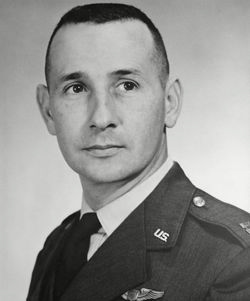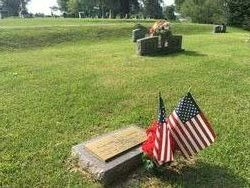b. 26/07/1933 Cornelia, Georgia. d. 24/02/1967 near Dalat, Vietnam.
DATE OF MOH ACTION: 24/02/1967 near Dalat, Vietnam.
Wilbanks was born July 26, 1933, in Cornelia, Georgia, to Travis and Ruby Wilbanks. He had a sister named Patricia and two brothers, Edwin and Norman.
As a young man, Wilbanks was known to be a good student who always tried his best. He delivered newspapers on his bicycle, played the piano at his church and participated in his school’s football team, according to a foundation set up in his name.
Wilbanks graduated from high school in 1950 and immediately enlisted in the Air Force, serving as a security guard during the Korean War. In 1954, he began training to be an aviation cadet and eventually earned his wings as a commissioned pilot. He spent his first few years as an instructor before serving as an F-86 Sabre Jet fighter pilot. He also served in Alaska and Las Vegas as an aircraft maintenance officer.
While stationed at Greenville Air Force Base in Mississippi, Wilbanks met Rosemary Arnold. They married shortly thereafter and had two children, a boy and a girl.
Wilbanks eventually trained as a forward air controller, a role that directly supports ground troops in combat zones. He served in that capacity when he was sent to Vietnam in April 1966, where he was assigned to the 21st Tactical Air Support Squadron.
Just prior to his deployment, Wilbanks learned his wife was pregnant with twins. They were born two weeks after he left for Southeast Asia.
During Wilbanks’ first 10 months in Vietnam, he earned the Distinguished Flying Cross and the Air Medal with 18 oak leaf clusters. By late February 1967, he’d flown 487 combat missions.
On February 24, 1967, he flew his last. That day, Wilbanks was doing visual reconnaissance in a Cessna O-1 Bird Dog — an unarmed, light aircraft — for a South Vietnamese Ranger Battalion that was preparing to attack near Dalat, South Vietnam. The battalion was accompanied by a small detachment of American advisors.
During the recon mission, Wilbanks discovered a large force of well-concealed Viet Cong forces poised on two hilltops, preparing to ambush the advancing rangers. Wilbanks quickly alerted the rangers, called gunships over the radio and began marking the enemy’s positions with white phosphorous rockets.
When the enemy forces realized they’d been compromised, they immediately began firing on Wilbanks’ aircraft with all the firepower they had. They also started their advance toward the exposed forward elements of the ranger battalion, which became pinned down by the devastating fire.
Wilbanks realized close-air support from the gunships wasn’t going to arrive in time to save the rangers from an onslaught. While he knew his unarmed, unarmored aircraft was limited in what it could do to help, Wilbanks didn’t hesitate to start providing cover fire for the men on the ground.
Flying at about treetop level, Wilbanks made several passes through a hail of gunfire, launching smoke rockets at the enemy below to inflict as many casualties as he could. When he ran out of smoke bombs, he pointed his personal survival weapon, an M-16 rifle, out of the aircraft’s window to strafe the advancing enemy troops — despite the increasing amount of anti-aircraft fire coming his way.
Wilbanks’ diversion succeeded at interrupting the enemy’s forward advance and took their attention away from the nearly trapped rangers, who were able to withdraw to safety. “Each pass, he was so close we could hear his plane being hit,” Army Capt. R.J. Wooten, the ranger battalion’s senior American advisor, later reported.
During Wilbanks’ final courageous pass, he suffered from serious injuries that led him to lose consciousness and crash his bullet-riddled aircraft between the opposing forces. The rangers rescued Wilbanks from the wreckage, but he died in a helicopter on the way to a hospital.
When Wilbanks died, he was about two months from finishing his yearlong tour of duty in Vietnam and returning home to his wife and four children, including the twins he never got to meet.
Wilbanks’ selfless actions saved the lives of numerous friendly troops. His valor was posthumously rewarded on January 24, 1968, when his wife received the Medal of Honor on his behalf from Air Force Secretary Harold Brown during a Pentagon ceremony.
Wilbanks was buried in Fayette Methodist Cemetery in Fayette, Mississippi, where he and his wife were married.
In 2001, Wilbanks was inducted into the Georgia Aviation Hall of Fame. Ten years later, Hilliard A. Wilbanks Middle School in Demorest, Georgia, was named in his honor. Around the same time, the Hilliard A. Wilbanks Foundation was formed to provide scholarships for deserving Georgia ROTC cadets. To this day, the middle school that is Wilbanks’ namesake displays his Medal of Honor for all its students to see.
MOH CITATION:
For conspicuous gallantry and intrepidity in action at the risk of his life above and beyond the call of duty. As a forward air controller Capt. Wilbanks was pilot of an unarmed, light aircraft flying visual reconnaissance ahead of a South Vietnam Army Ranger Battalion. His intensive search revealed a well-concealed and numerically superior hostile force poised to ambush the advancing Rangers. The Viet Cong, realizing that Capt. Wilbanks’ discovery had compromised their position and ability to launch a surprise attack, immediately fired on the small aircraft with all available firepower. The enemy then began advancing against the exposed forward elements of the ranger force which were pinned down by devastating fire. Capt. Wilbanks recognized that close support aircraft could not arrive in time to enable the rangers to withstand the advancing enemy onslaught. With full knowledge of the limitations of his unarmed, unarmored light reconnaissance aircraft, and the great danger imposed by the enemy’s vast firepower, he unhesitatimgly assumed a covering, close support role. Flying through a hail of withering fire at treetop level, Capt. Wilbanks passed directly over the advancing enemy and inflicted many casualties by firing his rifle out of the side window of his aircraft. Despite increasingly intense antiaircraft fire, Capt. Wilbanks continued to completely disregard his own safety and made repeated low passes over the enemy to divert their fire away from the rangers. His daring tactics successfully interrupted the enemy advance, allowing the rangers to withdraw to safety from their perilous position. During his final courageous attack to protect the withdrawing forces, Capt. Wilbanks was mortally wounded and his bullet-riddled aircraft crashed between the opposing forces. Capt. Wilbanks’ magnificent action saved numerous friendly personnel from certain injury or death. His unparalleled concern for his fellow man and his extraordinary heroism were in the highest traditions of the military service, and have reflected great credit upon himself and the U.S. Air Force.
BURIAL LOCATION: FAYETTE METHODIST CEMETERY, FAYETTE, MISSISSIPPI.
LOCATION OF MEDAL: HILLIARD A. WILBANKS MIDDLE SCHOOL, DEMOREST, GEORGIA.

